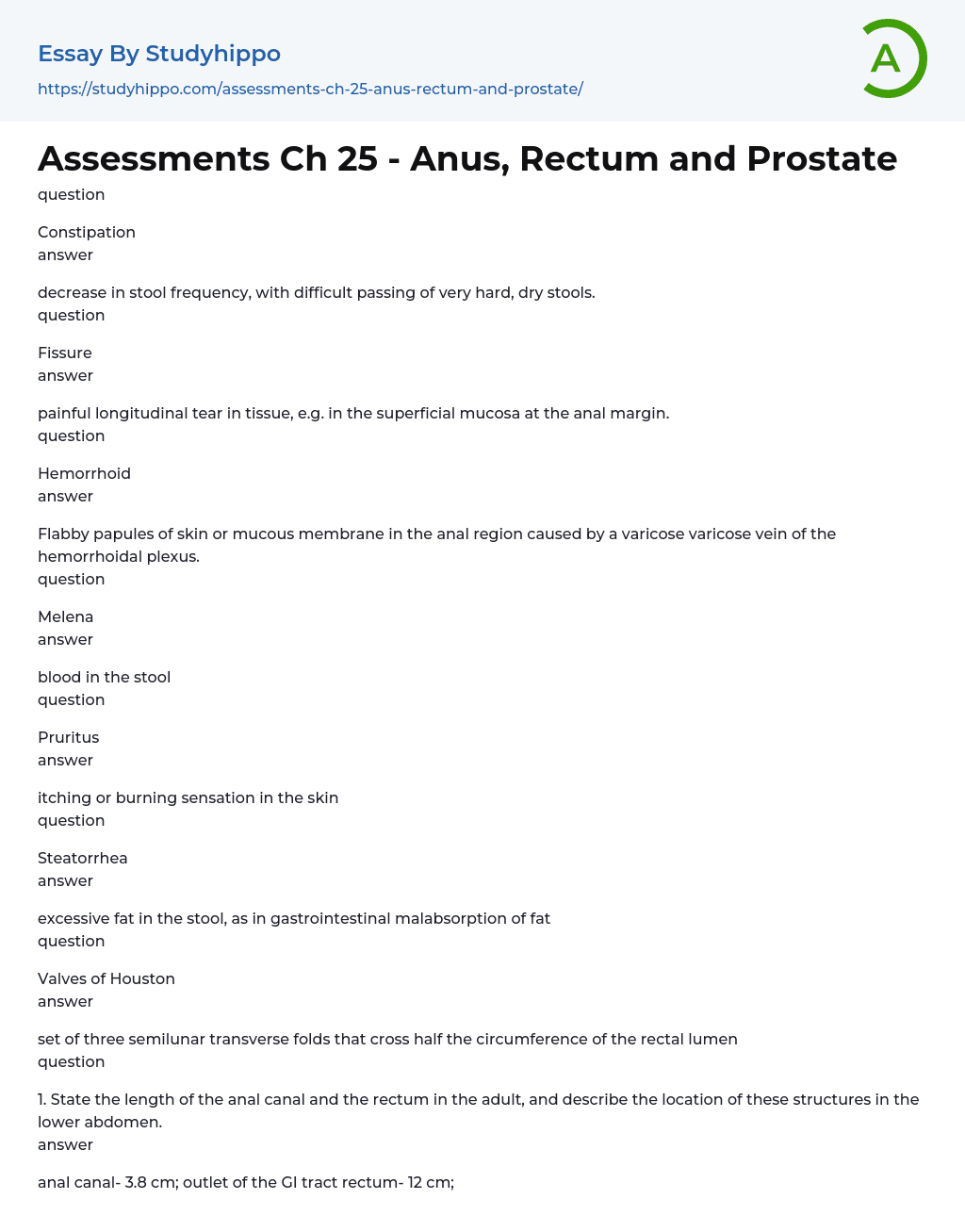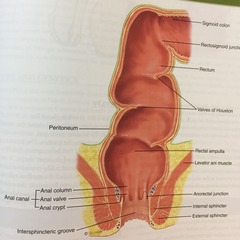

Assessments Ch 25 – Anus, Rectum and Prostate Essay Example
Topics:
View Entire Sample
Download Sample
Text preview
question
Constipation
answer
decrease in stool frequency, with difficult passing of very hard, dry stools.
question
Fissure
answer
painful longitudinal tear in tissue, e.g. in the superficial mucosa at the anal margin.
...
iv>
question
Hemorrhoid
answer
Flabby papules of skin or mucous membrane in the anal region caused by a varicose varicose vein of the hemorrhoidal plexus.
question
Melena
answer
blood in the stool
View entire sample
Join StudyHippo to see entire essay
question
Pruritus
answer
itching or burning sensation in the skin
question
Steatorrhea
answer
excessive fat in the stool, as in gastrointestinal malabsorption of fat
question
Valves of Houston
answer
set of three semilunar transverse folds that cross half the circumference of the rectal lumen
question
1. State the length of the anal canal and the rectum in the adult, and describe the location of these structures in the lower abdomen.
answer
anal canal- 3.8 cm; outlet of the GI tract rectum- 12 cm; distal portion of
the large intestine
question
2. Describe the size, shape, and location of the male prostate gland.
answer
In front of the anterior wall of the rectum, 2 cm behind the symphysis pubis -2.5 cm long, 4 cm in diameter -Bilobed with round or heart shaped, lateral lobes separated by median sulcus
question
3. List a few examples of high-fiber foods of the soluble type and the insoluble type. What advantages do these foods have for the body?
answer
Soluble: vegetables, fruits, legumes Insoluble: seeds and skins of fruits and vegies Advantages: normalize BMs, maintain bowel health, decrease cholesterol levels, help control blood sugar levels, aids in achieving healthy weight
question
4. List screening measures that are recommended for early detection of colon-rectal cancer and of prostate cancer.
answer
Colorectal: colonoscopy every 10 years, annual fecal immunochemical test Prostate: blood test for prostate-specific antigen and physical examination
question
5. State the method of promoting anal sphinter relaxation to aid palpation of the anus and rectum.
answer
Have patient take a deep breath and hold it Place pad of index finger gently against anal verge Will feel sphincter tighten then relax As relaxes, as patient to exhale and flex tip of finger and slowly insert it into the anal canal in direction towards umbilicus.
question
6. Describe the normal physical characteristics of the prostate gland that would be assessed by palpation:
answer
Size: 2.5 cm long, 4 cm in diameter, should not protrude more than 1 cm into rectum Shape: heart shaped with palpable central groove Surface: smooth Consistency: elastic, rubbery Mobility: slightly movable Sensitivity: nontender
question
7. Define the condition benign prostatic hypertrophy, list the usual symptoms experienced with this condition, and describe the physical characteristics.
answer
Caused by hormonal imbalance that leads to benign proliferation of benign adenomas. Gradually will impede urine output
question

7a. Fill in the labels indicated in the following illustrations (rectum).

answer
Peritoneum, Anal Canal: -column, -valve, -crypt, Interphincteric groove, External sphincter, Internal sphincter, Anorectal junction, Levator ani muscles, Rectal ampula, Valves of Houston, Rectum, Rectosigmoid junction, sigmoid colon.
question
1. The gastrocolic reflex is:
answer
A. a peristaltic wave.
question
2. Which population has the highest incident of benign prostatic hypertrophy (BPH)?
answer
B. African Americans.
question
3. Select the best description of the anal canal.
answer
C. 3.8cm long outlet of the gastrointestinal tract
question
4. Foods that may be beneficial to reduce the risk for colon cancer include:
answer
A. Foods high in fiber.
question
5. Which finding in the prostate gland suggests prostate cancer?
answer
D. Diffuse hardness
question
6. Which is true regarding the bulbouretral gland?
answer
C. It can be palpated during an examination of a male patient.
question
7. Normal stool is described as:
answer
B. Brown in color and soft in consistency.
question
8. Which symptoms suggest benign prostatic hypertrophy?
answer
C. Difficulty initiating urination and week stream.
question
9. A patient states that he is frequently constipated, and when he has a bowel movement he has rectal bleeding and pain. He does not feel any mass at his anal opening. "Do I have hemorrhoids, or is there something else wrong with me?" The examiner completes a rectal examination and explains that:
class="flashcard__img">
answer
C. The symptoms are consistent with internal hemorrhoids.
question
10. A patient states that he has frothy, foul-smelling stools that float on the surface of the water in the toilet bowl. What type of stool is this patient describing.
answer
A. Steatorrhea
question
11. Which of these is the correct technique to assess patency of the anal sphincter?
answer
B. Palpate the anus with a gloved finger to elicit sphincter control.
question
12. Which is a structure that secretes a thin, milky alkaline fluid to enhance the viability of sperm?
answer
B. Prostate gland
question
13. A newborn infant has a dark green stool 2 days after birth. How should you interpret this?
answer
A. This type of stool would indicate anal patency.
Popular Essay Topics
- John Locke essays
- 9/11 essays
- A Good Teacher essays
- A Healthy Diet essays
- A Modest Proposal essays
- A&P essays
- Academic Achievement essays
- Achievement essays
- Achieving goals essays
- Admission essays
- Advantages And Disadvantages Of Internet essays
- Alcoholic drinks essays
- Ammonia essays
- Analytical essays
- Ancient Olympic Games essays
- APA essays
- Arabian Peninsula essays
- Argument essays
- Argumentative essays
- Art essays
- Atlantic Ocean essays
- Auto-ethnography essays
- Autobiography essays
- Ballad essays
- Batman essays
- Binge Eating essays
- Black Power Movement essays
- Blogger essays
- Body Mass Index essays
- Book I Want a Wife essays
- Boycott essays
- Breastfeeding essays
- Bulimia Nervosa essays
- Business essays
- Business Process essays
- Canterbury essays
- Carbonate essays
- Catalina de Erauso essays
- Cause and Effect essays
- Cesar Chavez essays
- Character Analysis essays
- Chemical Compound essays
- Chemical Element essays
- Chemical Substance essays
- Cherokee essays
- Cherry essays
- Childhood Obesity essays
- Chlorine essays
- Classification essays
- Cognitive Science essays
Get an explanation on any task
Get unstuck with the help of our AI assistant in seconds
New

Haven't found what you were looking for?
Enter your email to get the sample
By clicking Send Me The Sample you agree to our Terms and Conditions. We won’t send you irrelevant messages or spam.
Thanks! The sample has been sent.
Check your Inbox or join StudyHippo now to benefit from thousands of ideas
Join StudyHippo now

Unfortunately copying the content is not possible
Tell us your email address and we’ll send this sample there.
By continuing, you agree to our Terms and Conditions.

